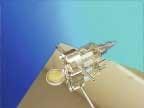E-lamp emits ultraviolet simply
Although excimer lasers provide light at ultraviolet wavelengths desirable for science, micromachining, and semiconductor processing, they have some drawbacks such as high initial and operating costs. For those applications not requiring the high output of excimer lasers, but requiring the same or similar wavelengths, engineers at TuiLaser (Germering, Germany) have developed a so-called "e-lamp"—a small, simple light-bulb-like emitter that excites excimer gases with an electron beam (see figure). In addition, the e-lamp works at wavelengths and with gases that an excimer laser cannot.
The single-phase air-cooled lamp, which needs no electrodes, emits in either a pulsed (with duration down to 10 ns) or a continuous-wave (CW) mode. An electron beam strikes a radiation area 0.5 mm2 in size, which emits light omnidirectionally. Optics with a numerical aperture of 0.5 capture a portion of this light for use. A CW power of up to 300 mW is radiated into 4p steradians, with the optics collecting up to 30 mW of the output. Total efficiency is approximately 10%.
In pulsed mode, pulses or arbitrary shape and duration can be formed. The pulse peak power can exceed the CW power by up to a factor of 1000.
The spectral characteristics differ depending on the gas used. Mixed gases provide a CW output power of 100 mW, including hydrogen emitting at 121.56 nm (Lyman-alpha source with a bandwidth of 1 pm) and krypton-xenon emitting at 147 nm with a 1-nm bandwidth. Pure rare gases emit up to 300 mW CW into a 10- to 20-nm bandwidth, including neon at 85 nm, argon at 126 nm, krypton at 147 nm, and xenon at 172 nm. Helium emits over a 60- to 100-nm wavelength range. Although operation with fluorine excimer gas mixtures is still under development, the standard excimer wavelengths of 157, 193, 248, and 351 nm can all be produced at 100-mW total power and a 1- to 5-nm bandwidth.
The electron-beam energy and current are on the order of 15 keV and 100 µA, according to Heinz Huber, vice-president of sales and application at TuiLaser. "We are intensely working on having a sealed-off volume, avoiding a gas flow," he notes. "But at the time it is not clear whether halide mixtures can stay in the lamp without flow."
Scaling the lamp up in power is of interest to the TuiLaser engineers. "Power scaling is done by increasing the emission area," says Huber. "In principle, the output power scales with the power of the electron beam. The intensity reaches a limit from the thermal load of the foil. Thus, power scaling can be reached by increasing the cross section of the electron beam. But this is reducing the quality of the light, because the emission surface is larger. We are working on more-powerful electron guns, as well as on larger foil surfaces."
Other aspects of the lamp are also being improved. The numerical aperture may be increased to 0.6 to collect more light, says Huber. Line and point sources are feasible, and a compact electron-beam-pumped laser may one day be possible.
Excimer-laser wavelengths have long been used in the integrated-circuit chipmaking industry—not just for photolithographic exposure, but also for inspection and metrology (measuring the accuracy and fidelity of the newly made chip features). Many of these applications do not require coherent light, which may allow excimer lasers to be replaced with e-lamps. Huber notes other possible applications of the lamp, including chemical analysis based on absorption, ionization, and fluorescence; spectrometry and spectroscopy; contamination analysis, and biomedical instrumentation for genomics and proteomics.

